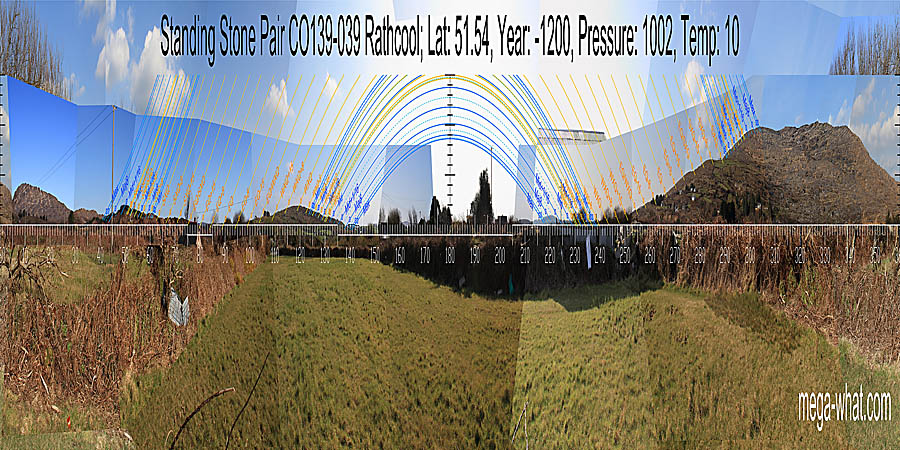 Rathcool Standing Stone Pair is about 2km north-east of Schull and only about 330m from Cooradarrigan Boulder-Burials
although it is a couple of kilometres by road.
Rathcool Standing Stone Pair is about 2km north-east of Schull and only about 330m from Cooradarrigan Boulder-Burials
although it is a couple of kilometres by road.South is obscured but probably on local ground [Pic].
North is at the foot of Mt Gabriel, just left of a very prominent dip [Pic].
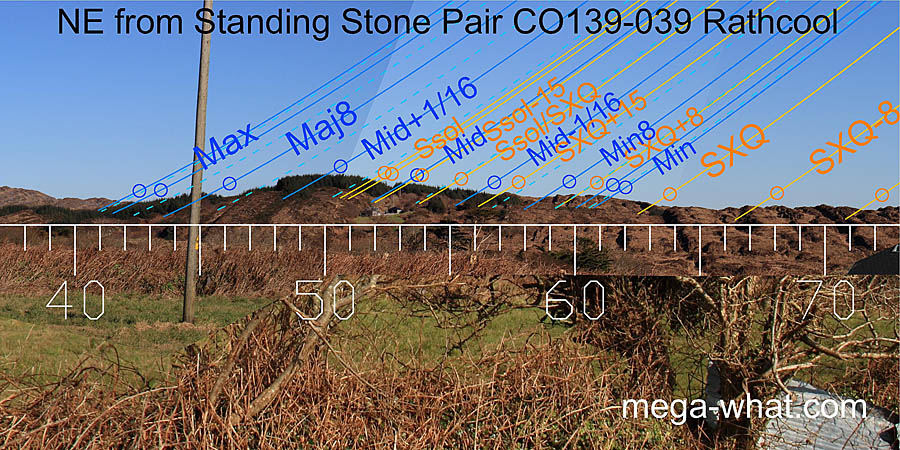 To the north-east the lunisticeLunistices are the most northerly and southerly moons of the month. The lunar equivalent of solstices - more.
range spans a hill, with summer cross-quarter at the south basal step and major standstillLunistice positions vary cyclically over an 18.6 year period but are fairly static for more than a year at either end of the range
at the north basal dip.
The hilltop has summer-solstice sun rising from it but is more of a lunar marker. The axes of both stones and of the pair all point north of the lunar extreme in this direction.
The SW stone axis [Pic] is less extreme than the NE stone axis [Pic].
To the north-east the lunisticeLunistices are the most northerly and southerly moons of the month. The lunar equivalent of solstices - more.
range spans a hill, with summer cross-quarter at the south basal step and major standstillLunistice positions vary cyclically over an 18.6 year period but are fairly static for more than a year at either end of the range
at the north basal dip.
The hilltop has summer-solstice sun rising from it but is more of a lunar marker. The axes of both stones and of the pair all point north of the lunar extreme in this direction.
The SW stone axis [Pic] is less extreme than the NE stone axis [Pic].
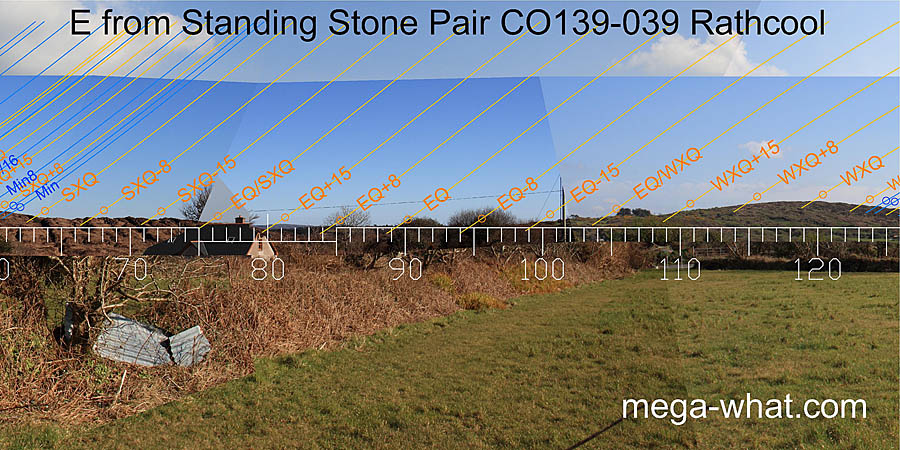 Eastwards is a dip but the lowest point is a week north of the equinox while the distant hilltop visible above the lowest dip of the local ground is two weeks north of it.
Eastwards is a dip but the lowest point is a week north of the equinox while the distant hilltop visible above the lowest dip of the local ground is two weeks north of it.
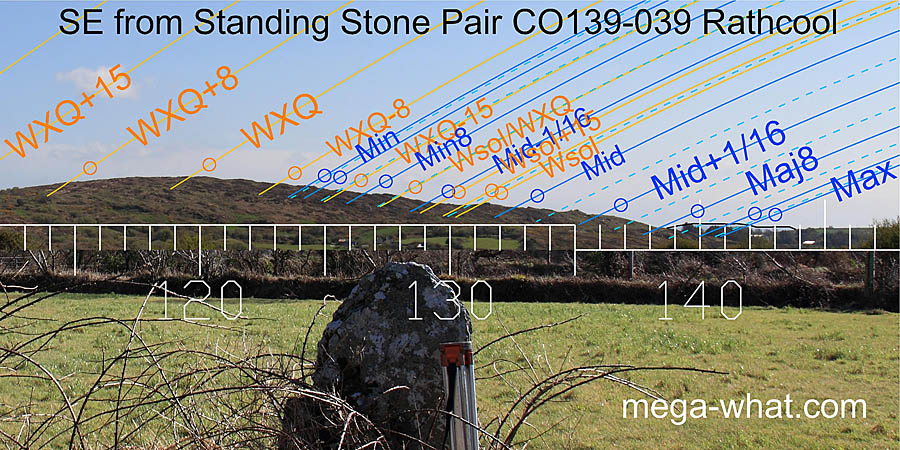 The south-east quadrant is occupied by a prominent hill which provides useful markers for the risings of winter sun and
summer solstice lunisticesLunistices are the most northerly and southerly moons of the month. The lunar equivalent of solstices - more..
The hilltop marks winter cross-quarter and its southern foot is a lunar major eighth. Major standstillLunistice positions vary cyclically over an 18.6 year period but are fairly static for more than a year at either end of the range
moonrises are on a more distant hill.
The south-east quadrant is occupied by a prominent hill which provides useful markers for the risings of winter sun and
summer solstice lunisticesLunistices are the most northerly and southerly moons of the month. The lunar equivalent of solstices - more..
The hilltop marks winter cross-quarter and its southern foot is a lunar major eighth. Major standstillLunistice positions vary cyclically over an 18.6 year period but are fairly static for more than a year at either end of the range
moonrises are on a more distant hill.
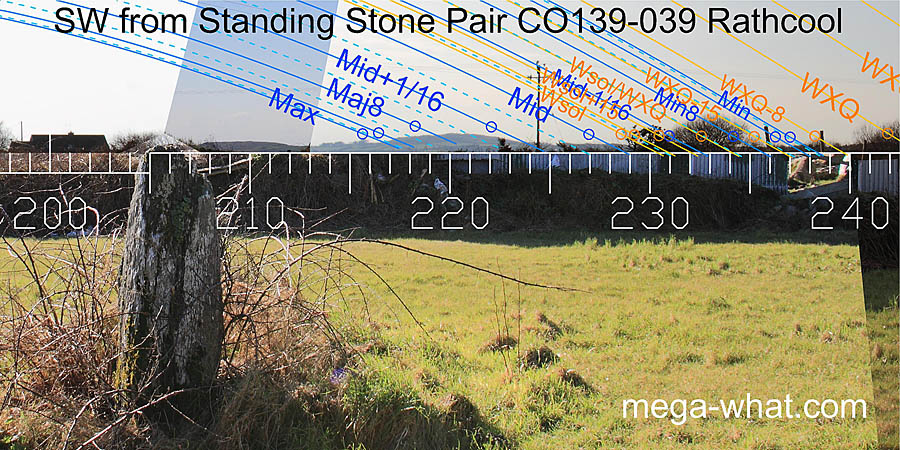
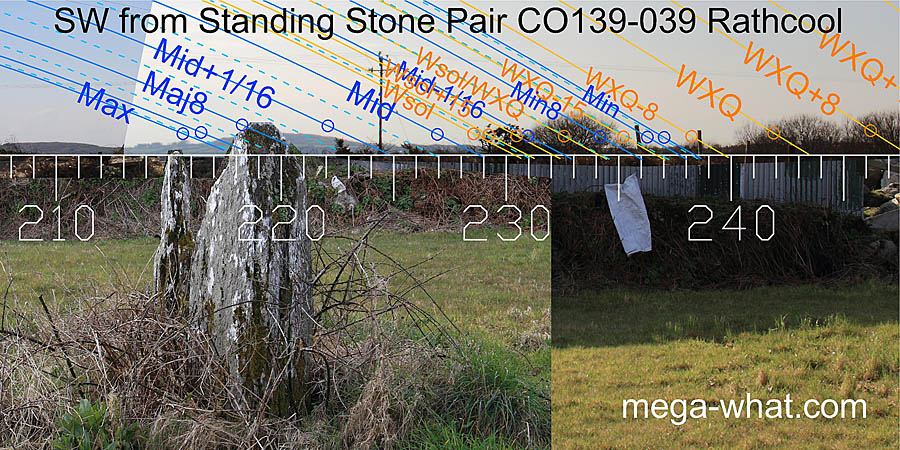 A shed now obscures the south-west but the lunisticeLunistices are the most northerly and southerly moons of the month. The lunar equivalent of solstices - more.
range spans a hill then runs down the ridge to its intersect with the nearer rising ground of Mt Gabriel.
The axes of the pair and the north-east stone point well south of the major standstillLunistice positions vary cyclically over an 18.6 year period but are fairly static for more than a year at either end of the range
moonset position but the south-west stone axis is much closer to it.
A shed now obscures the south-west but the lunisticeLunistices are the most northerly and southerly moons of the month. The lunar equivalent of solstices - more.
range spans a hill then runs down the ridge to its intersect with the nearer rising ground of Mt Gabriel.
The axes of the pair and the north-east stone point well south of the major standstillLunistice positions vary cyclically over an 18.6 year period but are fairly static for more than a year at either end of the range
moonset position but the south-west stone axis is much closer to it.
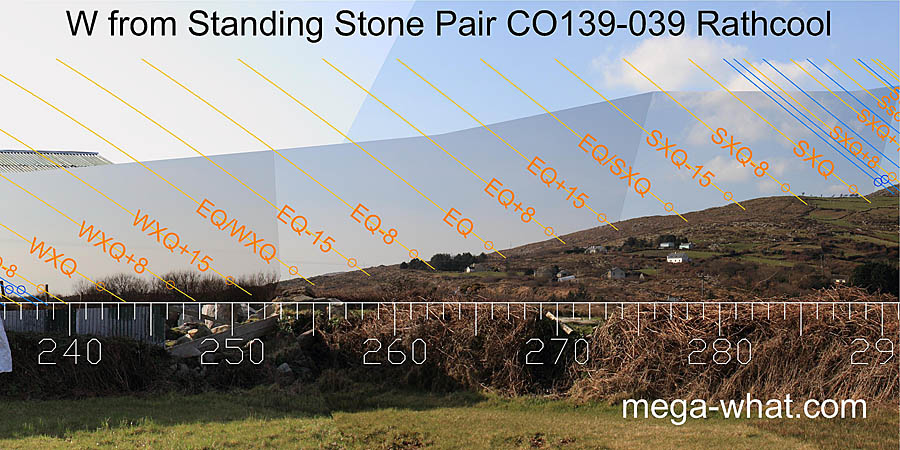 Westwards are the lower slopes of Mt Gabriel. Winter cross-quarters are on the very first rise. The equinox / winter cross-quarter midpoint is marked by a step and a more distant hill.
The equinox is at the foot of the next section of slope and the equinox / summer cross-quarter midpoint is at the foot of the next section again.
Summer cross-quarters are at the foot of the final slope.
Westwards are the lower slopes of Mt Gabriel. Winter cross-quarters are on the very first rise. The equinox / winter cross-quarter midpoint is marked by a step and a more distant hill.
The equinox is at the foot of the next section of slope and the equinox / summer cross-quarter midpoint is at the foot of the next section again.
Summer cross-quarters are at the foot of the final slope.
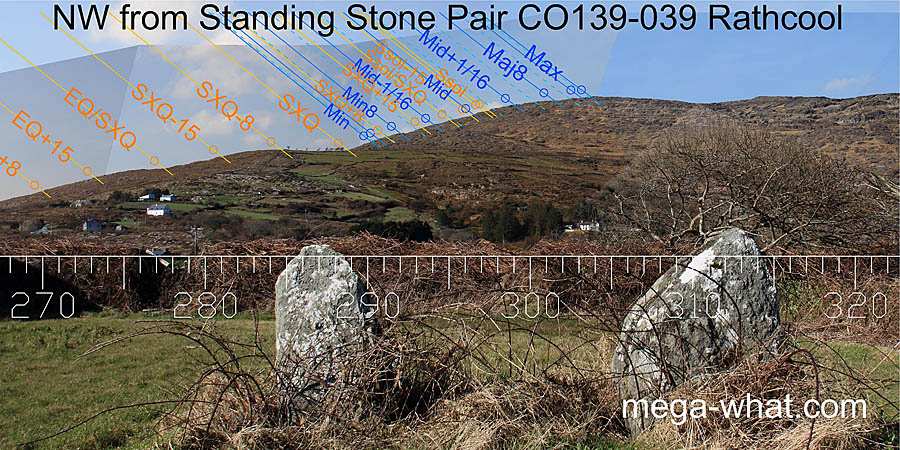 To the north-west, the south top of Mt Gabriel provides a good marker for the most extreme northerly moonset position.
The obvious step at its foot is accurate for the summer cross-quarter and the rocky profile of the slope provides more useful markers.
To the north-west, the south top of Mt Gabriel provides a good marker for the most extreme northerly moonset position.
The obvious step at its foot is accurate for the summer cross-quarter and the rocky profile of the slope provides more useful markers.
This Pair is the most easterly of three sites at the south foot of Mt. Gabriel.
- Two Boulder-Burials are about 330m to the south-west.
- About 500m in the same general direction is a probable fallen Standing Stone.
- O'Brien (1992,12) reported a "possible destroyed stone circle in Derryconnell townland (Nat. Museum of Ireland files)". This lost site, further to the east, is contextually credible and might perhaps be recovered using Whole Horizon Analysis Techniques. From such a location the lunisticeLunistices are the most northerly and southerly moons of the month. The lunar equivalent of solstices - more. range would spread further along Mt. Gabriel's ridge top.
- Standing Stone CO139-036 near the coast to the south remains unsurveyed.
This is one of a small number of Cork-Kerry type monuments that have extreme axes. Other Standing Stone Pairs with extreme axes are:
- Dromasta near Drimoleague.
- Mill Little in Coomhola.
- Kilcrohane on the Sheep's Head peninsula.
References
- Archaeological Survey of Ireland, record details. www.archaeology.ie/archaeological-survey-ireland
- O'BRIEN, WILLIAM 1992 Boulder-Burials: A Later Bronze Age Megalith Tradition in South-West Ireland. Journal of the Cork Historical and Archaeological Society 9:11-35.
- O'NUALLÁIN, SEÁN 1988 Stone Rows in the South of Ireland. Proceedings of the Royal Irish Academy 88c:179-256, p248, no.141.
- POWER, D. et al. 1992 Archaeological Inventory of County Cork, Volume 1: West Cork. Dublin: Stationary Office. p44, no.199.
